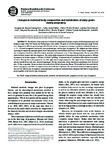Please use this identifier to cite or link to this item:
http://www.alice.cnptia.embrapa.br/alice/handle/doc/1040623| Title: | Changes in maternal body composition and metabolism of dairy goats during pregnancy. |
| Authors: | CASTAGNINO, D. de S.  HüRTER, C. J.   RIVERA, A. R.   LIMA, L. D. de   SILVA, H. G. de O.   BIAGIOLI, B.   RESENDE, K. T. de   TEIXEIRA, I. A. M. de A.   |
| Affiliation: | Douglas de Souza Castagnino, Universidade Estadual Paulista (Unesp) - Jaboticabal, SP, Brasil; Carla Joice Härter, Unesp - Jaboticabal, SP, Brasil; Astrid Rivera Rivera, Unesp - Jaboticabal, SP, Brasil; LISIANE DORNELES DE LIMA, CNPC; Herymá Giovane de Oliveira Silva, Unesp - Jaboticabal, SP, Brasil; Bruno Biagioli; Kleber Tomás de Resende; Izabelle Auxiliadora Molina de Almeida Teixeira. |
| Date Issued: | 2015 |
| Citation: | Revista Brasileira de Zootecnia, v. 44, n. 3, p. 92-102, 2015. |
| Description: | Abstract: The objective of this study was to evaluate the mobilization of nutrients in goats of different gestation types and pregnancy stages. Forty-four Saanen and Oberhasli goats were studied. The goats of each breed and gestation type (single or twin) were slaughtered at different gestational ages (80, 110, and 140 days of pregnancy), forming a completely randomized design in a 2 × 3 × 2 factorial arrangement (two breeds, three gestational ages, and two types of pregnancy). The slaughter procedure involved separating the empty body, mammary glands, uterus with membranes and fetal fluid, and fetus(es). For the females slaughtered at 140 days of pregnancy, blood was collected to analyze metabolites and hormones every 15 days during gestation. The dry matter (DM) intake was lower in goats with twin pregnancies. The relative daily retention rate of the nutrients in the body was positive at 100 days of pregnancy but became negative at 140 days (-0.18±0.25 g DM kg-1 of maternal body d-1) and did not differ with breed or number of fetuses. Fetal growth in twin pregnancies was 66% higher than in single pregnancies. The highest levels of ß-hydroxybutyrate and non-esterified fatty acids were observed beginning at 100 days of gestation. Serum total protein and albumin levels decreased after 125 days of gestation. Serum urea levels were reduced after 80 days of gestation. Plasma 17ß-estradiol levels increased with the advance of pregnancy, and IGF-1 was highest between 60 and 80 days of gestation. The maternal metabolism throughout pregnancy does not vary with the type of pregnancy, and pregnant goats need greater nutritional intake during the final third of the gestational period regardless of the breed or type of pregnancy. |
| Thesagro: | Caprino Cabra Nutrição animal Nutriente Prenhez Ingestão |
| NAL Thesaurus: | Goats Energy metabolism Animal nutrition Nutrients Pregnancy |
| Keywords: | Hormone profile Perfil hormonal Perfil metabólico Nutritional profile Pregnancy outcomes Type of pregnancy |
| DOI: | http://dx.doi.org/10.1590/S1806-92902015000300003 |
| Type of Material: | Artigo de periódico |
| Access: | openAccess |
| Appears in Collections: | Artigo em periódico indexado (CNPC)  |
Files in This Item:
| File | Description | Size | Format | |
|---|---|---|---|---|
| CNPC2015Changes.pdf | 1.31 MB | Adobe PDF |  View/Open |









